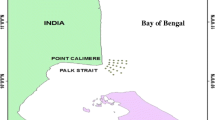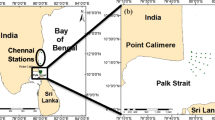Abstract
The U.S. Environmental Protection Agency Environmental Monitoring and Assessment Program (EMAP) uses water clarity as a water quality indicator for integrated assessments of coastal waters. After the publication of the first National Coastal Condition Report (USEPA, 2001c), the national water clarity reference value of 10% of ambient surface light at 1~m depth was reevaluated and modified to reflect expected differences in regional reference light conditions. These regional differences range from naturally turbid estuaries like those found in Mississippi and Louisiana to clear water estuaries expected to support extensive beds of submerged aquatic vegetation in, e.g., Florida and Tampa Bays. For the second National Coastal Condition Report, water clarity was assessed based on regional reference values (USEPA, 2004). Different regional water clarity reference values and data collection methods necessitated the development of a water clarity index based on light attenuation coefficients (k). This index incorporates regional reference conditions and is interchangeable with secchi depth and percent light transmission calculated from light meter measurements. Evaluation of the water clarity index shows that k values based on transmissivity at 1~m can be estimated from secchi depth measurements and successfully used as a surrogate for transmissivity calculated from light meter data. An approach for assessing water clarity in Gulf of Mexico estuaries using light meter data and secchi depth is presented.
Similar content being viewed by others
References
Burd, A. B. and Dunton, K. H.: 2001, ‘Field verification of a light-driven model of biomass changes in the seagrass Halodule wrightii’, Mar. Ecol. Prog. Ser. 209, 85–98.
Davies-Colley, R. J. and Vant, W.: 1988, ‘Estimation of optical properties of water from Secchi disk depths’, Water Resources Bull. 24, 1329–1335.
Gallegos, C. L. and Moore, K. A.: 2000, ‘Factors Contributing to Water-Column Light Attenuation’, in: Chesapeake Bay Submerged Aquatic Vegetation Water Quality and Habitat-Based Requirements and Restoration Targets: A Second Technical Synthesis. Chesapeake Bay Program, Annapolis, Maryland, pp. 35–54.
Intergovernmental Task Force on Monitoring Water Quality: 1995, ‘The Nationwide Strategy for Improving Water Quality Monitoring in the United States’, Final Report of the Intergovernmental Task Force on Monitoring Water Quality Technical Appendix E, Open File Report 95-742, Department of Interior, U.S. Geological Survey, Reston, Virginia.
Kenworthy, W. J. and Haunert, D. E. (eds.): 1991, ‘The Light Requirements of Seagrasses’, Proceedings of a Workshop to Examine the Capability of Water Quality Criteria, Standards and Monitoring Programs to Protect Seagrasses, NOAA Technical Memorandum NMFS-SEFC-287. http://shrimp.ccfhrb.noaa.gov/research/nmfs-sefc-tm287.pdf
Keefe, C. W., Flemer, D. A. and Hamilton, D. H.: 1976, ‘Seston distribution in the Patuxent River Estuary’, Ches. Sci. 17, 56–59.
Kirk, J. T. O.: 1994, Light and Photosynthesis in Aquatic Ecosystems, Cambridge University Press, Cambridge.
Kurtz, J. C., Jackson, L. E. and Fisher, W. S.: 2001, ‘Strategies for evaluating indicators based on guidelines from the Environmental Protection Agency's Office of Research and Development’, Ecol. Indic. 1, 49–60.
Landwehr, J. M., Reel, J. T., Rybicki, N. B., Ruhl, H. A. and Carter, V.: 1999, ‘Chesapeake Bay Habitat Criteria Scores and the Distribution of Submersed Aquatic Vegetation in the Tidal Potomac River and Potomac Estuary, 1983–1997’, Open-File Report, 99–219. U.S. Geological Survey.
Montes-Hugo, M. A., Alvarez-Borrego, S. and Giles-Guzman, A. D.: 2003, ‘Horizontal sighting range and secchi depth as estimators of underwater PAR attenuation in a coastal lagoon’, Estuaries 26, 1302–1309.
Paulsen, S. G., Hughes, R. M. and Larsen, D. P.: 1998, ‘Critical elements in describing and understanding our nation's aquatic resources’, J. Amer. Water Resources Assoc. 34, 995–1005.
Preisendorfer, R. W.: 1996, ‘Secchi disk science: Visual optics of natural waters’, Limnol. Oceanogr. 31, 909–926.
Science Subgroup: 1997, ‘Ecologic and P recursor Success Criteria for South Florida Ecosystem Restoration’, Report to the Working Group of the South Florida Ecosystem Restoration Taskforce, Planning Division, USACE, Jacksonville, Florida. Available at http://everglades.fiu.edu/taskforce/precursor/chapter6.html.
Stevens, Jr., D. L. and Olsen, A. R.: 2002, ‘Variance estimation for spatially balanced samples of environmental resources’, Environmetrics 14, 593–610.
Summers, J. K., Paul, J. F. and Robertson, A.: 1995, ‘ Monitoring the ecological condition of estuaries in the United States’, Toxicol. Environ. Chem. 49, 93–108.
Tett, P.: 2002, ‘The Environment’, Module 3. Unit 16: Light. School of Life Sciences, Napier University, Edinburgh. Available at http://www.lifesciences.napier.ac.uk/teaching/Env/En9light.html.
Tomasko, D. A., Bristol, D. L. and Ott, J. A.: 2001, ‘Assessment of present and future nitrogen loads, water quality, and seagrass (Thalassia testudinum) depth distribution in Lemon Bay, Florida’, Estuaries 24, 926–938.
USEPA: 2001a, Environmental Monitoring and Assessment Program (EMAP): National Coastal Assessment Quality Assurance Project Plan 2001–2004, EPA/620/R-01/002, United States Environmental Protection Agency, Office of Research and Development, National Health and Environmental Effects Research Laboratory, Gulf Ecology Division, Gulf Breeze, FL.
USEPA: 2001b, ‘National Coastal Assessment: Field Operations Manual’, EPA 620/R-01/003, United States Environmental Protection Agency, Office of Research and Development, National Health and Environmental Effects Research Laboratory, Gulf Ecology Division, Gulf Breeze, FL.
USEPA: 2001c, National Coastal Condition Report, EPA-620/R-01/005, United States Environmental Protection Agency, Office of Research and Development, Washington, D.C. Available at http://www.epa.gov/owow/oceans/NCCR/index.
USEPA: 2003, Ambient Water Quality Criteria for Dissolved Oxygen, Water Clarity and Chlorophyll a for the Chesapeake Bay and Its Tidal Tributaries, EPA-903/R-03/002, United States Environmental Protection Agency, Region III Chesapeake Bay Program Office, Annapolis, MD; Region III Water Protection Division, Philadelphia, PA, and Office Water, Office of Science and Technology, Washington, D.C.
USEPA: 2004, National Coastal Condition Report II, EPA-620/R-03/002. U.S. Environmental Protection Agency, Offices of Water and Research and Development, Washington, DC. Available at http://www.epa.gov/owow/oceans/nccr2/.
Author information
Authors and Affiliations
Corresponding author
Rights and permissions
About this article
Cite this article
Smith, L.M., Engle, V.D. & Summers, J.K. Assessing Water Clarity as a Component of Water Quality in Gulf of Mexico Estuaries. Environ Monit Assess 115, 291–305 (2006). https://doi.org/10.1007/s10661-006-6555-3
Received:
Accepted:
Published:
Issue Date:
DOI: https://doi.org/10.1007/s10661-006-6555-3




